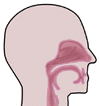  |
||
 |
Ciliopathies are mainly of genetic origin and reflect a major cause for loss of smell and taste. Correction of defects in these signaling pathways will prove of value to correct the sensory defects present in these patients. Ciliopathies are a major cause of loss of taste and smell which has not been well defined. Cilia are the anatomical portion of both taste buds and olfactory receptor cells which provide the initial step (the “business end”) of both taste and smell perception. (See June, What’s New.) Abnormalities in cilia function are mainly genetic in character and relate to abnormalities in each of four major sensory functions — vision, hearing, smell and taste. There are many studies extending over several years in which genetic abnormalities in ciliary function have been recognized and related to mechanistic defects in several diseases. These diseases are uncommon but they share common anatomical and biochemical defects. These diseases are genetic, well known, but clinically rare — Refsum’s disease, Joubert syndrome, Usher’s disease, Michel-Gruber syndrome, etc. Each of these diseases has been demonstrated to exhibit a genetic defect in which ciliary anatomy and function are abnormal. These abnormalities, which relate to abnormal cilia function, are manifested by clinical disorders in vision (retinitis pigmentosa which is associated with night blindness and loss of retinal rod function), hearing and kidney function (renal cysts which impair excretion of several metabolic products). We discovered loss of smell and taste in Refsum’s disease in 1973. This disease is comprised of several clinical symptoms including retinitis pigmentosa, sensorineural deafness, hyposmia (loss of smell), hypogeusia (loss of taste), demyelinating neuropathy, pes cavus, cerebellar ataxia and cranial nerve involvement. They also exhibit conduction defects in the heart and cardiomyopathy. While this disorder is dependent upon a metabolic abnormality in phytanic acid (levels of this substance are elevated in blood and other tissues due to defective alpha oxidation of phytanic acid) loss of smell, taste, hearing and vision are related to an underlying autosomal recessive abnormality manifested in impaired ciliary function. Biochemical changes in ciliary function can damage cilia in olfactory receptor cells in the nose, taste buds in the mouth, hair cells in the ear and retinal cells in the eye. Since odorants must bind chemically to cilia in the olfactory receptor and taste bud, sound must physically impinge on hair cells in the ear and light photons must physically impinge upon receptor cells in the retina of the eye, any pathology in cilia function would result in misperception of odors, tastes, sounds and light and be manifested as hyposmia, hypogeusia, deafness and night blindness, respectively. Biochemical mechanisms in cilia of these organ systems depend upon cell signaling to perform their necessary functions. This type of signaling involves several signaling processes including Wnt and sonic hedgehog (SSH) action. If inhibited, these signaling abnormalities induce defects in ciliary function. Since cilia balance activity of various types of signaling, both canonical and noncanonical, abnormalities in either Wnt and/or SSH signaling can alter taste, smell, auditory or visual function. These signaling mechanisms act through a number of other chemical moieties including ß catenin to maintain normal ciliary function. Loss of taste and smell are symptoms that relate to an underlying disease process. Physicians can identify a relationship that establishes the etiology of the symptoms which involves treating the condition that has caused the symptoms. Physicians who deal with symptoms of taste and smell loss need to understand the concept of the relationship to an underlying disease. Without understanding this relationship, physicians will not understand the disease process which caused the symptom. In that case, patients will be doomed to inadequate understanding and subsequently the lack of appropriate treatment for their taste and smell loss. Home
| The Clinic | Diagnosis
| Treatment | FAQ
| Press
|
|